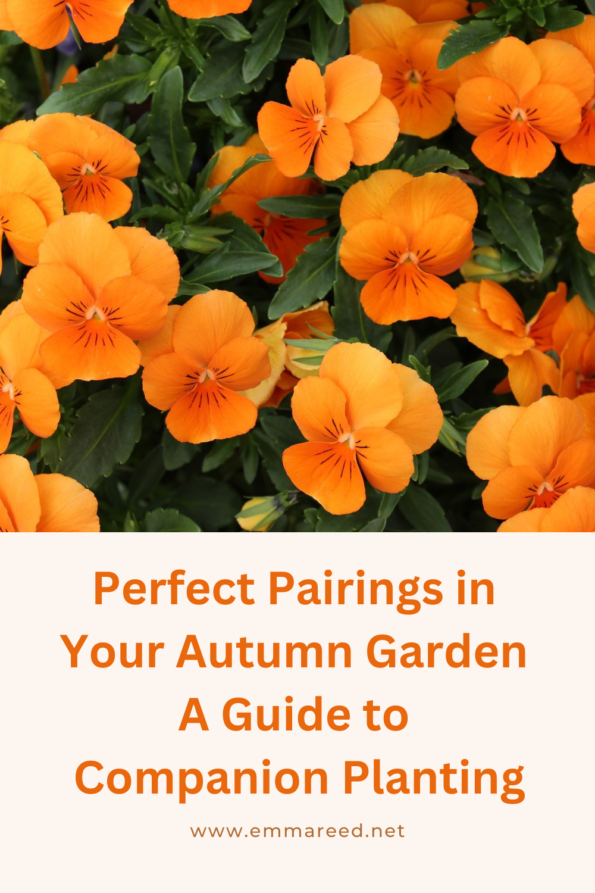
Perfect Pairings in Your Autumn Garden A Guide to Companion Planting

*Collaborative Post
Autumn is upon us, bringing cooler temperatures and vibrant foliage. But for gardening enthusiasts, it’s also the perfect time to think about companion planting. This age-old practice of pairing plants for mutual benefit can enhance the health and productivity of your autumn garden. In this guide, we’ll explore the principles of companion planting, highlight perfect plant pairings for the season, and offer practical tips to get you started.
What is Companion Planting?
Companion planting involves growing different plants together to improve growth, optimise space, and create a balanced ecosystem. This method can deter pests, enhance soil health, and boost yields. Understanding how plants can benefit each other can transform your garden into a thriving oasis.
Benefits of Companion Planting
Natural Pest Control
Pairing certain plants can naturally repel harmful insects. For example, marigolds deter nematodes, while basil repels aphids and mosquitoes. By strategically placing these plants, you can reduce the need for chemical pesticides.
Improved Soil Health
Legumes like peas and beans fix nitrogen in the soil, benefiting neighbouring plants that require more nitrogen. This natural fertilisation process enriches the soil and promotes healthier plant growth.
Enhanced Growth and Flavor
Certain plant combinations can improve the growth rate and flavour of crops. For instance, growing tomatoes with basil enhances the flavour of both plants. This symbiotic relationship extends beyond taste, promoting overall plant vigour.
Planning Your Autumn Garden
Assess Your Space
Before you start planting, evaluate your garden space. Consider the amount of sunlight, soil type, and available area. Also, don’t be afraid to utilise every space available, from flower beds to pots, window boxes and planters, you can successfully grow even in the smallest of areas.
Choose Compatible Plants
Select vegetable plants that have complementary growth habits and nutritional needs. For autumn gardens, cool-season vegetables like kale, broccoli, and carrots are excellent choices. Pair them with herbs and flowers that offer mutual benefits.
Prepare the Soil
Autumn is a great time to amend your soil. Add compost or organic matter to improve soil structure and fertility. This sets the stage for healthy plant growth and successful companion planting.
Perfect Autumn Pairings
Kale and Garlic
Kale thrives in cooler temperatures, and garlic acts as a natural pest deterrent. Planting garlic around your kale can help protect it from aphids and cabbage worms, ensuring a bountiful harvest.
Carrots and Onions
Carrots and onions are a classic companion planting duo. Onions repel carrot flies, while carrots improve soil structure for onions. This pairing maximises space and enhances the health of both crops.
Spinach and Radishes
Spinach and radishes are fast-growing cool-season vegetables. Radishes can help break up compacted soil, making it easier for spinach roots to grow. Additionally, radishes act as a trap crop for pests, protecting your spinach.
Broccoli and Dill
Broccoli benefits from the presence of dill, which attracts beneficial insects like ladybugs and parasitic wasps. These insects help control aphids and other pests, promoting healthier broccoli plants.
Lettuce and Chives
Lettuce and chives make a great team. Chives repel aphids and improve lettuce growth. Additionally, chives’ shallow root system allows lettuce to thrive without competition for nutrients.
Cabbage and Nasturtiums
Nasturtiums are excellent companions for cabbage. They attract aphids away from cabbage plants and repel whiteflies. This diversion tactic keeps your cabbage healthy and pest-free.
Peas and Spinach
Peas and spinach are cool-season crops that benefit each other. Peas fix nitrogen in the soil, enhancing spinach growth. Meanwhile, spinach provides ground cover, reducing weed competition.
Turnips and Mint
Turnips and mint create a harmonious partnership. Mint repels pests like aphids and flea beetles, protecting turnips. Ensure mint is planted in a container to prevent it from spreading aggressively.
Practical Tips for Companion Planting
Plan Ahead
Create a garden plan that outlines where each plant will go. Consider the spacing and sunlight requirements of each pairing to ensure optimal growth.
Rotate Crops
Practice crop rotation to prevent soil depletion and reduce the risk of disease. Rotating your plant pairings each season promotes soil health and balanced nutrient distribution.
Monitor and Adjust
Regularly check your garden for signs of pest activity or nutrient deficiencies. Adjust your plant pairings and amend the soil as needed to maintain a healthy garden ecosystem.
Conclusion
Companion planting is an excellent strategy for gardeners aiming to enhance their autumn gardens. By learning about the advantages of plant pairings and applying effective techniques, you can cultivate a flourishing and sustainable garden. Eager to elevate your gardening skills? Begin planning your ideal plant combinations now and think about incorporating autumn planting bulbs.
*This is a collaborative post. For further information please refer to my disclosure page.
Pin for later:





